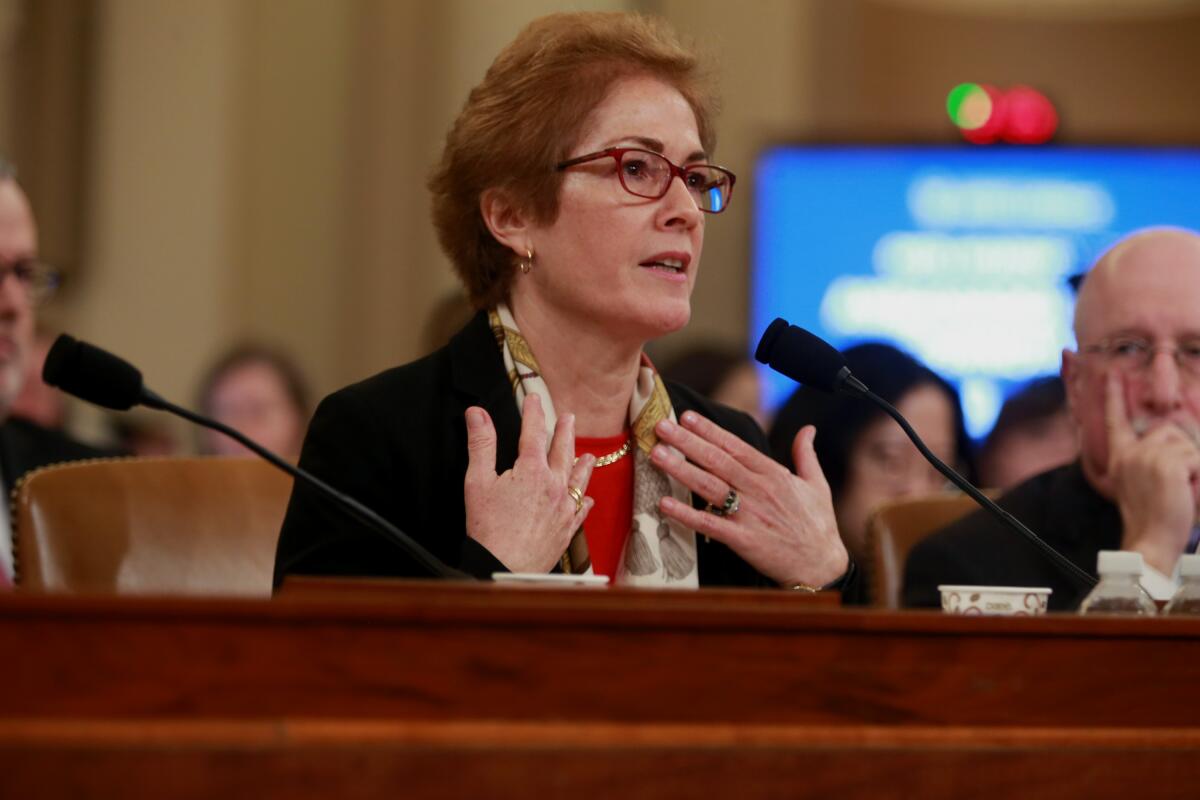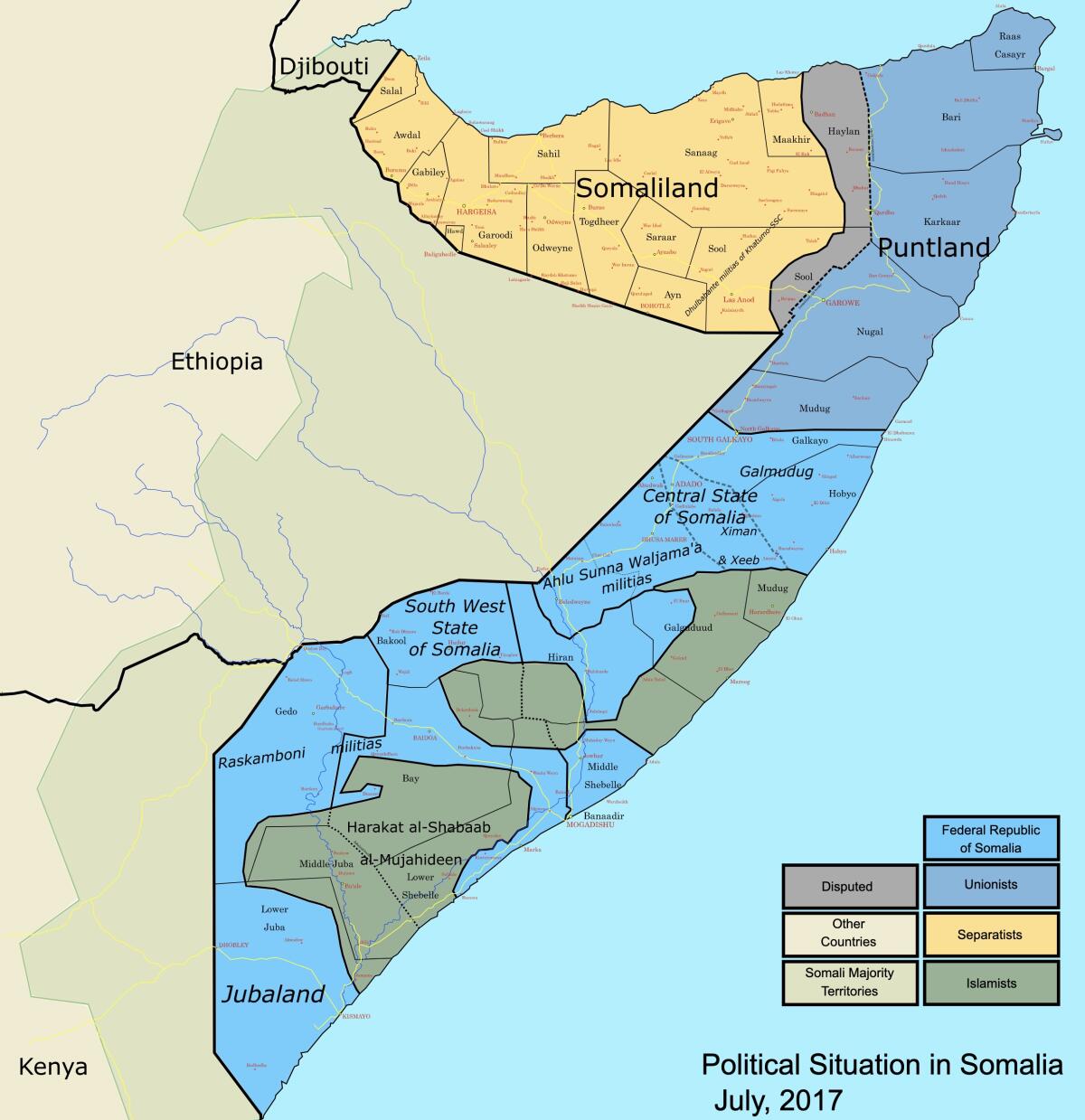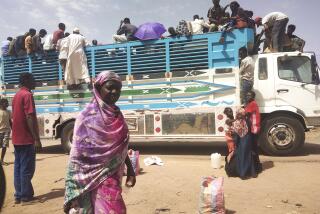Column: The truth about Somalia shows the absurdity of Trump’s attack on Yovanovitch

- Share via
Veterans of America’s misadventure in Somalia in the 1980s and ’90s must have been baffled Friday when President Trump seemed to blame former U.S. Ambassador to Ukraine Marie Yovanovitch for the African country’s collapse, in a tweet issued during her testimony at the public impeachment hearing.
“Everywhere Marie Yovanovitch went turned bad,” Trump tweeted. “She started off in Somalia, how did that go?”
Trump’s tweet stands as a new indication, if one were needed, of the president’s utter ignorance about the outside world and the history of America’s geopolitical involvements, in Africa and elsewhere.
Fierce government repression, heightened clan cleavages and animosities, gross levels of corruption, and low salaries all combined to accelerate the state’s decline.
— Ken Menkhaus, Somalia expert
I know, because I covered Somalia’s breakdown around the time Yovanovitch was there.
To suggest that as a junior member of the American delegation she could bear any responsibility for the breakdown is the height of absurdity. Somalia defeated the efforts of even seasoned diplomats and generals to turn it around. That’s evident from America’s catastrophic military intervention in 1992.
The actual dates of Yovanovitch’s posting to Somalia are unclear. We know that she joined the foreign service in 1986, and that Somalia was her first assignment. She eventually served as ambassador to Kyrgyzstan and Armenia before taking on her assignment in Ukraine in 2016, from which she was unceremoniously dumped by Trump in May.
Let’s take a look at the Somalia dossier.
In the mid- to late 1980s, when Yovanovitch arrived in Mogadishu, the capital, Somalia was a crippled orphan of the Cold War. Its murderous and cunning dictator, Mohamed Siad Barre, played the Soviet Union and the U.S. against each other.
More than 150 trucks were lined up in front of a makeshift partition of rusting sea containers closing off one end of the port of this crippled, starving capital.
Both recklessly provided Siad Barre with enormous supplies of firearms, which ultimately would end up in the hands of the civilian population. Siad Barre provoked a war with neighboring Ethiopia in 1977, destabilizing the entire Horn of Africa and creating a population of hundreds of thousands of famine-stricken refugees in the Ogaden region bordering both countries.
In the view of many experts in the region, Somalia was already a “failed state” by the time of Yovanovitch’s arrival.
“Fierce government repression, heightened clan cleavages and animosities, gross levels of corruption and low salaries all combined to accelerate the state’s decline,” reported political scientist Ken Menkhaus, who lived in Somalia as a Fulbright scholar during that period. “The public school system, a source of pride and progress in the 1970s, crumbled. Production on state-run farms and in factories plummeted. Government ministries were almost entirely dysfunctional.”
The Somali state became “an instrument of repression and expropriation, a tool to dominate political opponents and rival clans, expropriate resources, and above all serve as a catchment point for foreign aid that was then diverted into the pockets of civil servants clever, powerful, or well connected enough to place themselves at strategic spigots in the foreign aid pipeline,” Menkhaus wrote.
Beset by insurgents on all sides, Siad Barre saw his authority wither away until he was ridiculed as no more than “the mayor of Mogadishu.” He finally lost even that authority when he was driven into exile in 1991. Authority in the capital itself was split between two battling warlords, Mohammed Farah Aidid and Ali Mahdi Mohamed, whose zones of control were marked by a green line patrolled by their armies.
That was the situation when I traveled to Mogadishu in August 1991. It was the most horrifying and terrifying experience of my career.
Along with three other foreign correspondents, I had cadged a ride on a UNICEF plane carrying relief supplies. We landed at a dirt airstrip that had been built by drug runners 35 miles out of town because the main airport had been closed to United Nations flights since May 31, when looters there made off with more than 6.5 tons of Unimix, an emergency food for malnourished children, and 1 ton of medicine brought in by UNICEF and the Committee of the Red Cross. Armed gangs clearly had been tipped that both agencies’ planes would be on the ground at the same time. The stolen Unimix amounted to meals for 30,000 children.
A German relief agency gave us a lift into town in a Toyota van, its sliding side door removed to give two armed guards clear shots out the opening. Upon reaching the UNICEF compound in Mogadishu where we would spend the night, Job One was to hire a “technical” — a pickup with a machine gun mounted in the back. For daily rent of $150 in U.S. cash, we got a driver, a guard armed with a Kalashnikov to sit with him in the front seat, and a barefooted 13-year-old boy to tend the machine gun in the truck bed.
The threat of random violence was incessant and all-defining. Nothing was illegal because there is no authority except the gun. Relief agencies would get daily reports from local contacts about which neighborhoods and streets are unsafe to travel.
Every passing vehicle seemed to bristle with gun barrels sticking out the windows; every male on the street, even the children, carried a weapon. At the Red Sea port of Mogadishu, an average of five people were killed every day. Scarcely a relief ship docked without being looted.
In one episode, mobs emptied a dockside warehouse of 7,000 tons of food in 10 hours. “The whole population of Mogadishu was running around looking like ghosts because they were covered in wheat flour,” a relief worker told us. “It was a free-for-all.”

Only one foreign diplomat remained in the country, the morose Egyptian ambassador. “I must have made someone in Cairo very angry,” he told us fatalistically. He explained to us the bizarre internal politics of the capital.
Aidid and Ali Mahdi, as it happened, were members of the same clan — in other words, relatives. Brought together for occasional cease-fire talks, they would smother each other in familial embraces and pledge mutual fealty as brothers, and then return to their own headquarters and promptly resume exchanges of gunfire.
The back alleys of the city harbored thousands of the destitute, most of whom had fled warfare and drought in the west and south of the country. They lay spent and emaciated on the main streets as Land Cruisers flying blue U.N. flags or fluttering Red Cross pennants sped past, their occupants trying to hold back the disorder enough to get a few thousand tons of food into town.
The U.N. compound served a dinner of tough and stringy camel meat, washed down with warm camel milk with a repulsive bacony aroma. Nighttime accommodations were provided at the U.N.’s upstairs dormitory. The crack of gunfire persisted through the night. As a rule, you placed your mattress on the floor to sleep, for you never knew when a stray bullet might come pinging through the open window.
The inflow of Somalis had turned Mogadishu into a refugee camp of 1 million people. Most of them, particularly women, children and the elderly, were barely clinging to life, for after bags of food were distributed to such families, the looting began at gunpoint. Relief workers talked of the need to “flood” Mogadishu with food.
“Once there is plenty of food it is not worth stealing, hoarding or fighting over,” Tony Knight of the Save the Children Fund told us. But they also recognized that bringing the port under control would be an undertaking entirely beyond their capabilities.
This provided the rationale for the ill-starred American intervention of 1992, Operation Restore Hope. President George H.W. Bush, seeking to burnish his humanitarian credentials, was determined to get food into the country. Assured by his military advisors that the port could be secured and the operation completed in time for the inauguration of Bill Clinton as president, Bush ordered 25,000 troops into Somalia.
The port was quickly secured so food could move off cargo ships and onto dry land. The Americans sponsored cease-fire talks between Aidid and Ali Mahdi, and boasted about getting the two warlords to embrace like brothers. As the Egyptian ambassador might have predicted, the accord didn’t last.
America’s naivete about Somali politics and the limited scope of its military campaign presaged the failure of the effort. It would not be long before the American forces who took control of the port pulled out, allowing the battling clans to once again take control of relief supplies.
Clinton reduced the American presence in Somalia but also invested the troops with more daunting responsibilities. These included in late 1993 a mission to arrest Aidid, which culminated in a massive firefight chronicled in the book “Black Hawk Down,” ending with 18 U.S. soldiers and as many as 1,000 Somalis killed. Clinton finally withdrew the last of the U.S. troops in March 1994.
One evening last week, one of the United Nations’ armed Pakistani soldiers on duty in Somalia made a rare foray off his base inside Mogadishu’s ruined international airport and into town.
Somalia’s recovery since then has been less than encouraging. The economy is kept afloat largely by remittances from Somalis living abroad, but even so the per capita gross domestic product is lower today, indexed to inflation, than it was in the 1990s. “Poverty, life expectancy and child malnutrition” were “not much different than they were in the prewar period” before Siad Barre’s ouster, according to a 2012 report by the Central Bank of Somalia.
Somalia remains “among the poorest countries in the world,” the World Bank said in a highly pessimistic 2018 survey. Sectarian and clan violence is still the rule; more than 500 people were killed in twin bomb blasts in the heart of Mogadishu in October 2017.
This is the situation that Trump decided was Marie Yovanovitch’s fault. He knows less about Somalia than a couple of generations of American decision-makers who turned the country into a ward of the international community by inundating it with arms and not caring much about the consequences, then tried to rectify their mistakes by committing further mistakes.
In other words, Somalia was “bad” long before Yovanovitch got there, despite Trump’s ignorant assessment. Asked at Friday’s hearing to respond to Trump’s accusation, she replied, “I don’t think I have such powers — not in Mogadishu, Somalia.” Virtually no one did. Someone should tell the president that.
More to Read
Sign up for Essential California
The most important California stories and recommendations in your inbox every morning.
You may occasionally receive promotional content from the Los Angeles Times.











